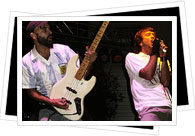Tenerife Music: Native Legacy
 When the ambitious Spanish conquest eventually made its way to the Canary Islands and took them as part of the ever-expanding Spanish empire, there were already indigenous communities inhabiting the islands. While these "Guanches" were - by European standards - quite primitive, they did have a developed culture which included religion, language and music. While very little remains of the indigenous forms of music and dance, there is evidence that they existed.
When the ambitious Spanish conquest eventually made its way to the Canary Islands and took them as part of the ever-expanding Spanish empire, there were already indigenous communities inhabiting the islands. While these "Guanches" were - by European standards - quite primitive, they did have a developed culture which included religion, language and music. While very little remains of the indigenous forms of music and dance, there is evidence that they existed.
Following a Portuguese expedition in 1341, sailors made mentions of "endechas" - sad songs of lament - and various native Canarian dances. The first documented accounts of these endechas, however, were written after the 1443 death of Guillén Peraza. Written by Leonardo Torriani in Castilian Spanish, he obtained and included collections of sung native language. One form of native music that has lasted right through today is "Tajaraste." Hailing from Tenerife's neighbor La Gomera, it was a form of music danced to the rhythm of a drum - or a "tajaraste" - and today has become its own genre.
Tenerife Music: Traditional
Due to the combination of cultures playing into the Canary Island's colorful history, traditional Tenerife music - just like its food, society, sports, etc. - is a fusion of African, Latin American, European and indigenous Guanche music. The first step towards the traditional Tenerife's music we hear today was the Spanish conquest and subsequent colonization of the islands.
As Spanish culture began intermingling with the pre-existent native culture, traditional Spanish music - such as malagueñas, fandangos and seguidillas - hit Tenerife's early music scene. The outcome came in the form of fusion dances like isas (a typical Canarian dance) , folias (a Canary Island - Spanish dance with castanets), the Rama de Agaete (a ritual dance that still exists today) and el canario- a slow music and dance which actually later extended through Europe as a result of the slave trade. On the musical end, songs and styles like the Meda (a song dedicated to the Virgin), the Ranchos de Pascua (Easter music) and the Vivo (a traditional song sung at ceremonies, events, funerals, etc.)
Tenerife Music: Folk
Tenerife - as well as its fellow archipelago members -
has a popular and celebrated folk music scene. The city of La Orotava, for example, is famous for its folk groups and boasts hundreds of them! You can basically divide popular folk music, which you'll typically finding setting the atmosphere at traditional festivals and events, into two major groups.
The first group comprises old, time-honored songs - and often accompanying dances - whose words and music have no specific authors but yet have been passed down through the generations. The second group can more or less be called the "modern" group, which includes songs attributed to known folk authors and musical groups such as José María Millares, Néstor Álamo, Los Sabandeños, Los Gofiones and La Parranda de los Buches. This contemporary form of Tenerife folk music is part of a huge musical movement across the Canary Islands that has enjoyed a major resurgence throughout the 20th century.
Tenerife Music: The Timple
One of the most fundamental and representative elements to traditional Canarian folk music is the timple, or the Canarian guitar. Similar to a ukulele, the timple is like a miniature version of the guitar and strumming its four (or five) strings produces light, higher-pitched music.
The timple's origins are more than likely rooted in the Baroque guitar, which was introduced to Tenerife and its fellow islands after the Spanish conquest. While it was long-regarded as an accompanying instrument in traditional Canarian music, contemporary musicians like Totoyo Millares totally revolutionized the instrument and its musical possibilities by converting it into a soloist instrument. Nowadays, the timple is used to play anything from traditional Baroque to jazz and pop music.
Tenerife Music: Today
Tenerife may be out there in the Atlantic Ocean, but it has kept right up with major musical trends like jazz, rock and - these days - even hip hop. Jazz music first made its mark in the Canary Islands back in the 1940's with La Palma's Minerva jazz. The style simmered and enjoyed a certain popularity, but really came into its glory in the 1980's when South American jazz arrived in the islands and rapidly created a following.
Throwing in additional European and African, the Canary Islands produced first-rate artists - such as Polo Ortí, Kike Perdomo, Gato Gótico and Jazz Borondón - and a style of jazz known for stylistic innovation. Today, the annual Canary Islands Jazz Festival draws internationally renowned artists year after year and makes Tenerife and its fellow Canary Islands a veritable jazz nucleus.
Meanwhile, when rock 'n' roll hit England's music scene, the style almost immediately surged in Tenerife. From then on, it has followed world trends through epochs of psychadelic, disco, punk, heavy metal, pop and hip hop. Endless performers, singer / song-writers and bands have emerged since 1956's Los Diablos del Rock - the Canary Islands' first rock group - and the rock scene boasts year-round festivals throughout the islands.
On the more classical side, Tenerife's Symphony Orchestra is one of the best in the world and performs in Santa Cruz's incredible, ultra-modern Auditorio de Tenerife.